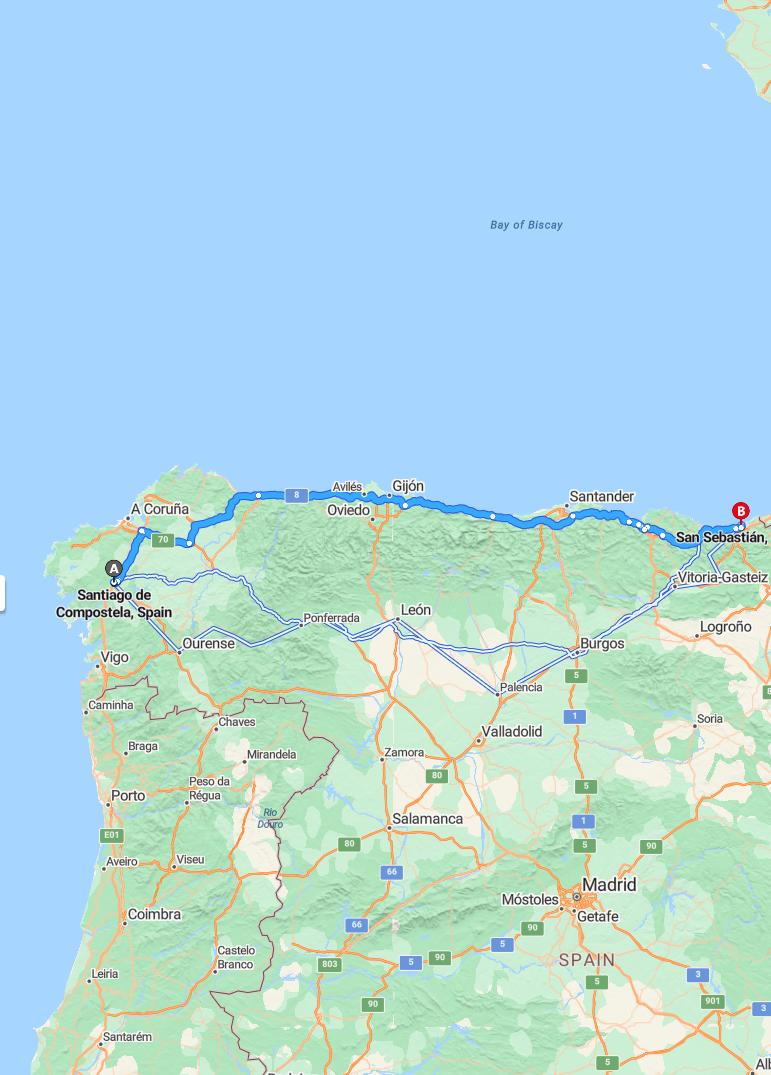Distance and estimated driving time
The journey from Santiago de Compostela to San Sebastian spans approximately 422 miles along the E-70 route, with an estimated driving time of about 6 hours and 15 minutes. This scenic drive takes travelers through diverse landscapes, offering a picturesque experience of northern Spain. Planning ahead is recommended to ensure timely breaks and refreshment stops along the way. Overall, this route provides an efficient and enjoyable way to explore the region's cultural and natural attractions.
Driving route
Embarking on a scenic journey from Santiago de Compostela to San Sebastian offers travelers an enriching experience through diverse Spanish regions. Starting in the historic city of Santiago de Compostela, known for its stunning cathedral, the route progresses through Lugo, famed for its well-preserved Roman walls. Continuing along the coast, Gijon and Aviles provide vibrant maritime atmospheres and cultural attractions. As the trip advances into Santander, visitors can enjoy beautiful beaches and scenic vistas before reaching the picturesque city of San Sebastian, renowned for its culinary excellence and stunning bay views. This route showcases a blend of historical landmarks, coastal beauty, and vibrant city life, making it a memorable travel adventure.

Best time to travel
The ideal time to travel from Santiago de Compostela to San Sebastian is during late spring (May to June) or early autumn (September to October), when the weather is generally mild and pleasant. Traveling in these months allows you to enjoy comfortable temperatures and fewer crowds at popular destinations along the route. Summer months (July and August) can be busy, especially at coastal points like Gijon and San Sebastian, and temperatures may be higher. Visiting during the shoulder seasons ensures a more relaxed experience and better opportunities to explore the scenic landscapes and cultural attractions along the way.
Road conditions and traffic updates
The drive from Santiago de Compostela to San Sebastian offers scenic views, but travelers should be aware of variable road conditions and traffic updates along the route. Generally, major highways such as the A-6 and AP-8 are well-maintained, ensuring smooth travel between cities like Lugo, Gijon, and Santander. However, during peak hours or holiday seasons, congestion may occur, especially closer to urban centers like Gijon and Santander. It is advisable to check real-time traffic updates before departure to ensure a safe and efficient journey.
Weather forecast during the trip
During the trip from Santiago de Compostela to San Sebastian, travelers can expect varied weather conditions along the route. In Galicia, including Santiago de Compostela and Lugo, mild temperatures with occasional rain showers are common, especially in the early part of the day. As you progress further east to Gijon, Aviles, and Santander, the weather tends to become more unpredictable, with cloud cover and possible light rain or drizzle. Upon reaching San Sebastian, the climate generally remains mild, with a higher likelihood of clear skies and pleasant conditions suitable for sightseeing and outdoor activities.
Rest stops and scenic viewpoints
As you drive from Santiago de Compostela to San Sebastian, several rest stops and scenic viewpoints offer opportunities to enjoy the journey. In Lugo, you can pause to admire the historic Roman walls and take a break at local cafes. Gijon and Aviles provide charming seaside vistas and architecturally interesting spots, perfect for stretching your legs. Further along, Santander offers stunning coastline views from its waterfront parks, culminating in the picturesque landscapes of San Sebastian, where panoramic sights of the bay await travelers eager to capture memorable moments.
Local attractions en route
Traveling from Santiago de Compostela to San Sebastian offers a rich array of local attractions along the route. In Lugo, visitors can admire the stunning Roman walls that encircle the city, a UNESCO World Heritage site, and explore its historic old town. Gijon and Aviles in Asturias boast vibrant maritime culture, with Gijon featuring beautiful beaches and lively promenades, while Aviles is home to the impressive Oscar Niemeyer International Cultural Centre. Finally, Santander presents picturesque coastal scenery, historic sites like the Magdalena Palace, and inviting beaches, making the journey both scenic and culturally enriching.
Transportation alternatives (bus, train)
Traveling from Santiago de Compostela to San Sebastian offers several transportation options, including bus and train services. The bus provides a cost-effective and flexible way to traverse the route, with multiple daily departures that pass through key cities such as Lugo, Gijon, Aviles, and Santander. Alternatively, taking the train offers a more comfortable and efficient journey, with routes that connect major cities and provide scenic views along the way. Both options require planning ahead, but they enable travelers to choose the mode that best suits their scheduling preferences and travel style.
Safety tips for long-distance driving
When undertaking a long-distance drive from Santiago de Compostela to San Sebastian, safety should be a top priority. Ensure your vehicle is in good condition, with tires, brakes, and fluids checked before departure. Plan your route in advance, including rest stops to avoid fatigue and stay alert throughout the journey. Additionally, keep emergency supplies such as a first aid kit, water, and a flashlight in your vehicle to handle any unforeseen situations safely.
Tips for navigation and GPS usage
When driving from Santiago de Compostela to San Sebastian, utilizing reliable GPS navigation can greatly enhance your journey by providing real-time directions and traffic updates. It is advisable to pre-program your route before departure, ensuring you are familiar with key turns and major highways such as the A-8. Carry a backup map or offline navigation option in case of signal loss in remote areas like Lugo or Gijon. Additionally, stay attentive to road signs and local traffic conditions to make necessary adjustments and ensure a smooth, stress-free trip.
